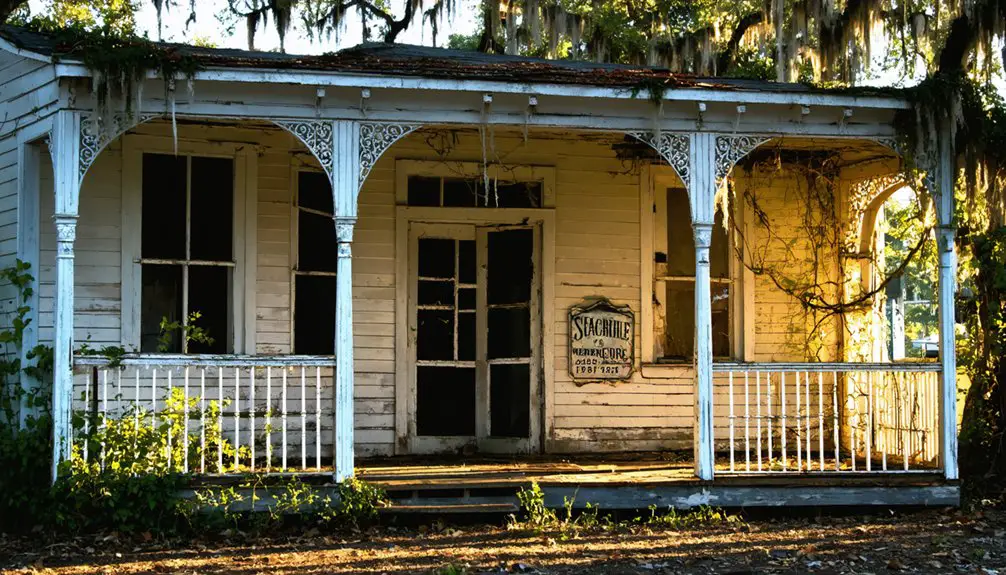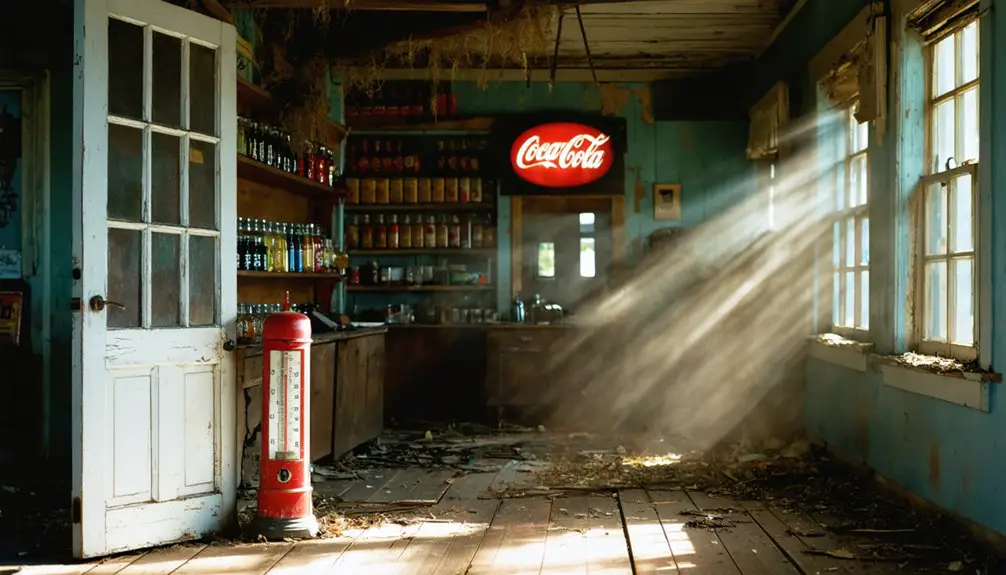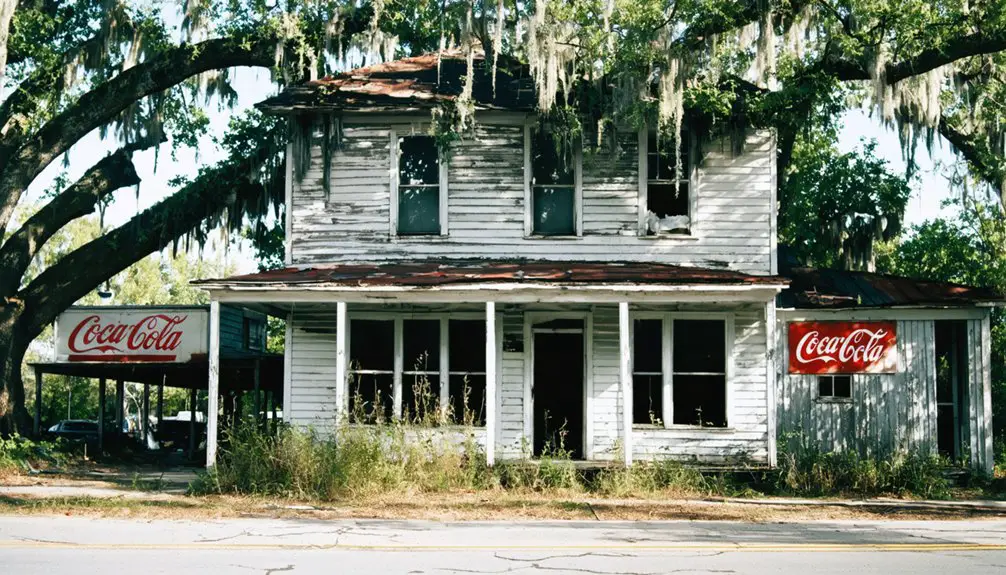You’ll find Slighville along Florida’s Suwannee River, where George Franklin Drew established it in 1861 as a lumber production powerhouse. At its peak, Drew & Bucki Lumber Company employed 500 workers, making it Florida’s largest sawmill operation, with a thriving community of 1,000 residents. Though the town declined after timber resources dwindled, its industrial ruins and Drew Mansion’s remnants tell a fascinating story of Florida’s forgotten lumber empire.
Key Takeaways
- Slighville was founded in 1861 by George Franklin Drew along the Suwannee River as a lumber mill town.
- The town reached its peak population of 1,000 residents in the 1870s during the lumber industry boom.
- Drew & Bucki Lumber Company operated Florida’s largest steam-powered sawmill, employing nearly 500 workers.
- The town declined due to depleted timber resources, the 1921 store fire, and economic hardships during the Great Depression.
- Preservation efforts continue today as community groups work to protect remaining historic structures from development and deterioration.
Origins and Early Settlement
While Florida was embroiled in the Civil War, George Franklin Drew established Ellaville in 1861 along the western banks of the Suwannee River.
Drew moved his sawmill from Columbus across the river, choosing a strategic location near the Withlacoochee River confluence. He named the town after Ella, his longtime African-American servant.
The settlement patterns quickly emerged around Drew’s partnership with Louis Bucki, a Prussian immigrant. Together, they built Florida’s largest steam-powered sawmill, employing 500 workers. The Masonic lodge and churches were among the first prominent structures built in the growing community. The town established two schools to serve the growing population.
This industrial anchor sparked rapid community organization, with the town gaining a railroad extension, steamboat dock, and essential infrastructure.
You’ll find that early settlement success hinged on Drew’s $35,000 post-war investment, which transformed Ellaville from a small mill town into a thriving community of 1,000 residents by the 1870s.
Rise to Economic Prominence
You’ll find Florida’s historical sawmill industry exemplified in Slighville, where railroad connections and timber processing drove the town’s rapid expansion.
Drew & Bucki Lumber Company established itself as the largest sawmill operation in Florida during its heyday. The arrival of rail lines enabled efficient transportation of lumber products while supporting a workforce of nearly 500 at the mill’s peak operations.
The steam-powered sawmill, processing yellow pine from over 1,200 local acres, established Slighville as a significant industrial center with direct shipping routes to Jacksonville and beyond. A bustling Masonic lodge and several churches served the town’s growing population of approximately 1,000 residents.
Railroad Development Fuels Growth
As Florida’s ambitious railroad projects expanded in the 1850s, Slighville emerged as an essential point along the newly chartered Florida Railroad – a 155-mile route connecting Fernandina to Cedar Key.
You’d find crews of both enslaved and white laborers clearing dense forests and swamps, battling insects and wildlife to lay the tracks that would transform this wilderness into a crucial commercial corridor. The project was led by visionary David Yulee’s railroad, which secured 500,000 acres in federal land grants to support construction. The railroad became one of the state’s first steam-powered lines, revolutionizing transportation in the region.
The railroad’s completion brought unprecedented economic growth to Slighville, connecting it to major trading hubs and distant markets.
You could now ship cotton, citrus, and other goods more efficiently, avoiding the dangerous 800-mile detour around the Florida Straits.
The reliable daily train schedules turned Slighville from an isolated settlement into a bustling town, integrating it into Florida’s expanding statewide trade network.
Sawmill Powers Local Industry
The railroad’s arrival in Slighville sparked an industrial revolution, with the town’s first steam-powered sawmill opening in 1853. The mill’s advanced sawmill technology, including circular saws and steam engines, let you witness production rates that far exceeded the earlier water-powered operations common in Florida at that time. Similar to the state’s overall industry growth that saw 135 sawmills operating by 1880, Slighville’s operations expanded rapidly.
You’d find workers earning around 10.5 cents per hour, both poor whites and blacks who’d left agricultural jobs for better opportunities. Despite the dangerous conditions, the sawmill became Slighville’s largest employer, transforming the sleepy town into a bustling industrial hub. The management strictly enforced No Smoking signs throughout the facility due to frequent mill fires that plagued the industry.
The company built worker housing, schools, and recreational facilities to keep families in town. By 1860, you could see timber products valued at over $1.4 million flowing through Slighville’s rail yards, cementing the town’s economic prominence.
Daily Life and Community
In Slighville’s heyday, you’d find residents gathering at the Masonic lodge, two churches, and schools that formed the social backbone of this industrial town.
Transportation and commerce flourished after the railroad arrived, connecting the town to wider markets and opportunities.
You could purchase daily necessities at the bustling commissary, which served as both general store and community hub where workers and families crossed paths.
While specific details of social events are limited, the steamboat dock, churches, and schools provided spaces where you’d likely encounter community celebrations, religious services, and educational activities that defined daily life in this Florida mill town. The thriving economy was supported by logging and turpentine industries that brought prosperity to the region.
Social Gatherings and Events
During Ellaville’s heyday, social life revolved around several key gathering spots that served the town’s thousand residents.
You’d find community celebrations taking place at two local churches, while the Masonic lodge hosted regular meetings for its members. The bustling steamboat dock wasn’t just for commerce – it’s where you’d catch up on the latest news as travelers came and went along the Suwannee River.
Social interactions flourished at the commissary store, a daily meeting point for locals. Later, Camp Suwannee emerged as a vibrant social hub, offering a restaurant, Gulf filling station, and camping facilities.
The sawmill, employing over 500 workers, created its own social network, while two schools brought families together through educational activities and events.
Educational and Religious Life
While Ellaville thrived as a bustling mill town, its educational and religious institutions formed the bedrock of community life.
You’d find two schools serving the town’s 1,000 residents in the early 1870s, providing essential literacy and numeracy skills to children of mill workers and locals.
The town’s two churches became more than just places of worship – they were crucial social hubs where you could connect with fellow residents and find moral guidance.
These religious activities strengthened community bonds and supported the families working at the sawmill and railroad. A Masonic lodge complemented these educational institutions, offering additional social support and charitable services.
Together, these pillars of community life shaped Ellaville’s character until its eventual decline in the early to mid-20th century.
Commerce and Daily Routines
Life in Slighville revolved around its bustling sawmill operations, which employed over 500 workers during the town’s industrial peak.
You’d find the town’s ghostly commerce centered around general stores, commissaries, and steamboat docks where residents purchased daily necessities or traded goods. The local post office, integrated into stores, kept you connected to the outside world through mail orders.
Your daily routines would’ve included shopping at company stores, where you could buy goods on credit, and visiting the Masonic lodge or churches for social gatherings.
The abandoned routines of Slighville’s past reveal a tight-knit community where business owners often served multiple roles.
Railroad lines and river transport kept you linked to broader markets, while local agriculture and wild game supplemented your food supplies.
Notable Buildings and Landmarks

Among Slighville’s most significant historical structures, the Drew Mansion ruins stand as a reminder of the town’s prosperous past. Built in 1868 by future Florida governor George Franklin Drew along the Suwannee River, the mansion served as the town’s centerpiece until vandals stripped it bare and fire claimed it in the 1970s.
Today, you’ll find only the foundation and nature reclaiming the grounds.
Nearby, you’ll discover the remnants of the 1928 Suwannee River Store, which replaced an earlier store lost to fire in 1921. The store complex, which included a post office run by the Noegel family, functioned as the town’s commercial hub until 1942.
You can still spot traces of Camp Suwannee’s grounds, where travelers once enjoyed amenities like a Gulf filling station and restaurant.
Industrial Legacy and Development
During the late 19th century, Slighville’s industrial growth flourished through the convergence of railroads, timber production, and phosphate mining.
You’ll find evidence of this boom in the remnants of narrow-gauge rail lines that once transported phosphate ore and lumber from local operations to main transportation arteries.
The area’s economic interdependence centered on 87 regional sawmills, which processed pine, oak, and cypress for construction and naval stores.
The region’s economic lifeblood flowed through its 87 sawmills, transforming local timber into vital construction materials and naval supplies.
The industrial transportation network expanded when railroad barons like William D. Chipley developed essential connections to Gulf Coast ports.
These rail lines weren’t just moving raw materials – they were building Slighville’s future.
Steam-powered equipment revolutionized both mining and lumber operations, while government land sales at low prices fueled further industrial expansion throughout the region.
The Path to Abandonment

Slighville’s industrial prosperity wouldn’t last forever. The economic decline began when timber resources dwindled, forcing the massive steam-operated sawmill that once employed 500 workers to scale back operations.
You’d have witnessed the town’s population plummet from its 1870s peak of 1,000 residents as jobs disappeared.
Community fragmentation accelerated after a series of devastating setbacks. The 1921 store fire damaged crucial businesses, while the 1929 shooting death of postmaster Henry Charles Noegel destabilized local commerce.
The Great Depression dealt further blows, and by 1942, even the post office had closed.
The Drew Mansion’s destruction in the 1970s, despite $10,000 in state preservation funds, symbolized the town’s final descent into abandonment. Without jobs, services, or infrastructure, families had no choice but to seek opportunities elsewhere.
Preservation Efforts Today
While many Florida ghost towns fade into obscurity, preservation efforts in Slighville have sparked intense debate between developers and local activists since 2023.
Abandoned Florida settlements may vanish, but Slighville’s preservation battle ignites fierce controversy as activists confront development plans.
You’ll find community advocacy groups fighting to protect the deteriorating structures despite significant pressure for commercial redevelopment.
The Florida Trust for Historic Preservation, the state’s leading nonprofit in this field, has stepped in to evaluate the site’s historical significance.
You’re witnessing a classic preservation challenge as subtropical weather continues to damage the remaining structures, while limited funding hampers restoration efforts.
The battle intensifies as preservationists push for archaeological surveys and formal recognition, hoping to secure the ghost town’s future through state grants and legal protections.
Local residents maintain that Slighville’s historical character matters more than new development projects.
Exploring the Historic Site

Today’s visitors to the former Ellaville site will find a network of nature trails weaving through what was once Florida’s largest steam-operated sawmill town.
You’ll discover scattered brick remnants from the old mills and railroad structures hidden beneath the forest canopy, while ghost stories of the murdered postmaster Henry Charles Noegel still echo through the ruins.
As you explore, you’ll encounter archaeological findings near the Suwannee River, including the Drew Mansion’s weathered foundation.
The historic cemetery offers a glimpse into the lives of the town’s original settlers.
While most structures have vanished, you can trace Ellaville’s footprint along the riverbank where the steamboat dock once stood, imagining the bustling industrial hub that employed over 500 workers during its heyday.
Frequently Asked Questions
Were There Any Major Crimes or Murders Reported in Ellaville’s History?
You’ll find only one documented major historical crime in Ellaville: Joe Jenkins shot and killed postmaster Henry Noegel in 1929 at the Suwannee River Store. No other unsolved mysteries exist.
What Happened to Ella, the Servant After Whom the Town Was Named?
Like many untold stories of the antebellum South, Ella’s legacy fades into historical silence. You won’t find records of her fate after the town’s naming – her story lost in time’s shadowy depths.
Did Any Famous People Besides George Drew Live in Ellaville?
Besides Drew, you’ll find Louis Bucki, a Prussian immigrant businessman, as the only other notable historical figure in Ellaville. Local legends mention Robert Lee Milliner, but his residency isn’t confirmed.
Were There Any Documented Supernatural Occurrences or Ghost Stories in Ellaville?
You won’t find documented ghost sightings or haunted locations in Ellaville’s history. Historical records and local sources focus on the town’s economic decline rather than supernatural occurrences.
How Did Native American Communities Interact With the Town’s Early Settlers?
You’ll find evidence of cultural exchange and cooperative trade between Seminoles and early settlers, with indigenous groups supplying beef and food while adapting European tools and livestock into their traditional practices.
References
- https://www.youtube.com/watch?v=0TLWOUfei-M
- https://www.youtube.com/watch?v=yJ4TrNBZ0Sk
- https://www.tiktok.com/@floridadallas/video/7455505913118461226
- https://www.atlasobscura.com/places/the-ghost-town-of-ellaville-madison-florida
- https://www.tiktok.com/@socialshepherdadventures/video/7342301852702100778
- https://www.worldatlas.com/travel-stories/north-florida-s-infamous-ghost-town.html
- https://www.youtube.com/watch?v=C03nyMEzFr4
- https://theforgottensouth.com/ghost-town-ellaville-florida-history-governor-drew-mansion/
- https://abandonedfl.com/the-town-of-ellaville/
- https://www.frrm.org/zerfas1/



